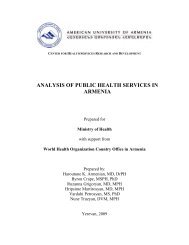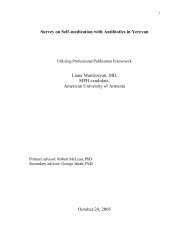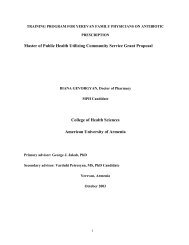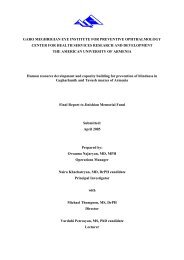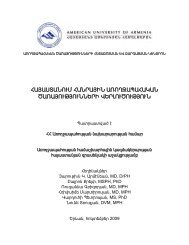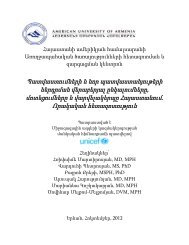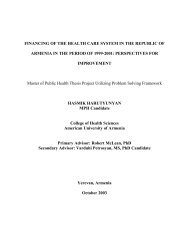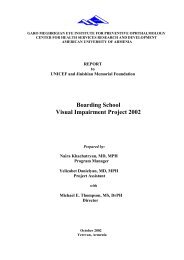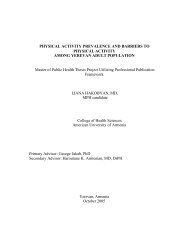A M E R I C A N U N I V E R S I T Y O F A R M E N I A - CHSR
A M E R I C A N U N I V E R S I T Y O F A R M E N I A - CHSR
A M E R I C A N U N I V E R S I T Y O F A R M E N I A - CHSR
You also want an ePaper? Increase the reach of your titles
YUMPU automatically turns print PDFs into web optimized ePapers that Google loves.
stress, loss of sense of control, and low self-esteem” [6]. In this situation, children are especially<br />
vulnerable.<br />
Though stunting in preschool children is falling globally and is expected to continue to fall,<br />
reaching 29% in 2005 compared with 47% in 1980 [7], malnutrition is the most important risk<br />
factor of mortality and morbidity for a number of childhood illnesses [2]. The main causes of<br />
malnutrition are inadequate access to food, inadequate care of children and women, and<br />
inadequate access to basic health services, sometimes combined with an unhealthy environment<br />
[8]. Such diseases like acute-respiratory diseases, food allergy, functional stomach and gut-<br />
intestinal disorders are linked to feeding practices during the first 12 months of life [9].<br />
In developing countries, another issue, also identified as a priority, is anemia, the main cause of<br />
which is using poor quality supplementary food, especially given before six months and in rural<br />
areas. This increases the risk of diarrheal and other nutrition-related diseases, and instead of<br />
growth advantage it is likely leading to a growth faltering [8,10]. However, nutrition and health<br />
status are not determined simply by food supply. Rather, these are the outcomes of three groups<br />
of factors: household food security, good health services (including a healthy environment), and<br />
quality of care [2,10].<br />
The UNICEF-Cornell Colloquium on Care and Nutrition of the Young Child in 1995<br />
developed the same concept describing the various factors that influence the quality of care. The<br />
framework, dedicated to care and nutrition of children, developed a conceptual model of<br />
nutrition status of young children. It highly emphasized the essence of access to health services,<br />
both preventive and curative procedures as well as good care, defined as a provision in the<br />
household and the community of time, attention and support to meet the physical, mental and<br />
social needs [8].<br />
6




